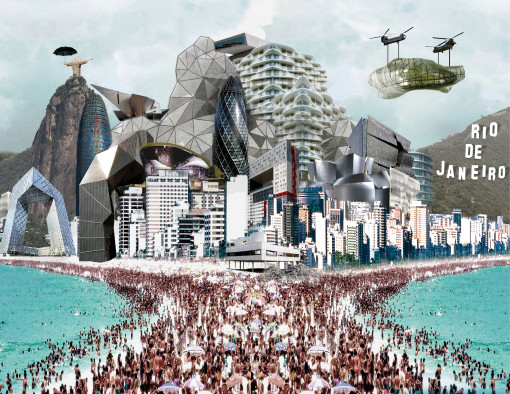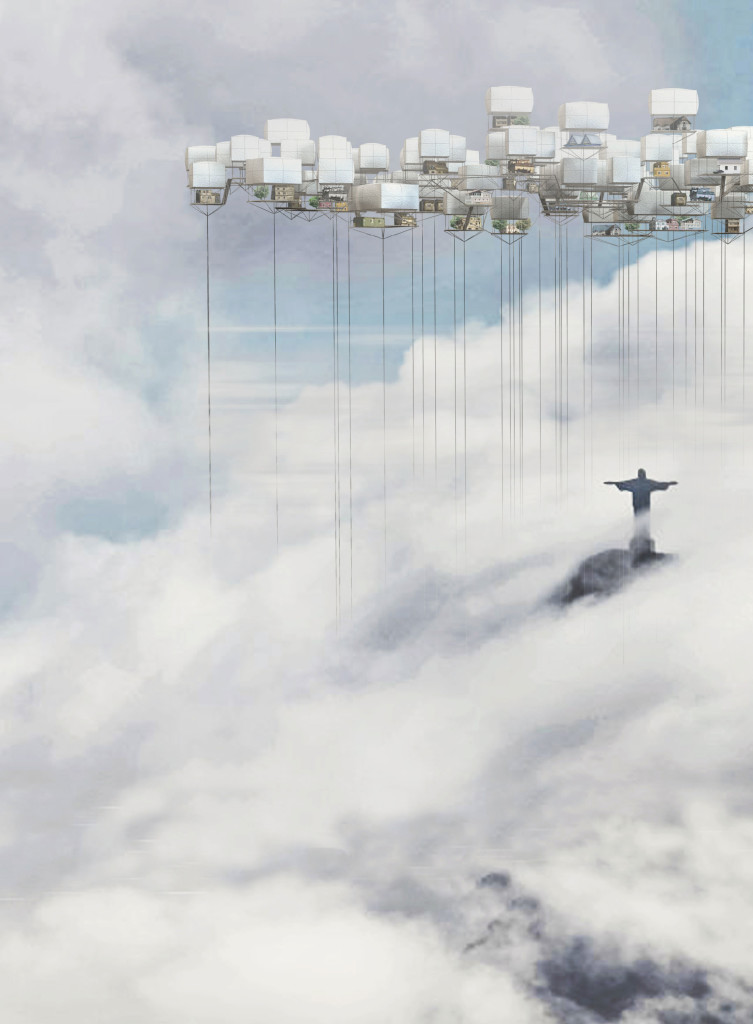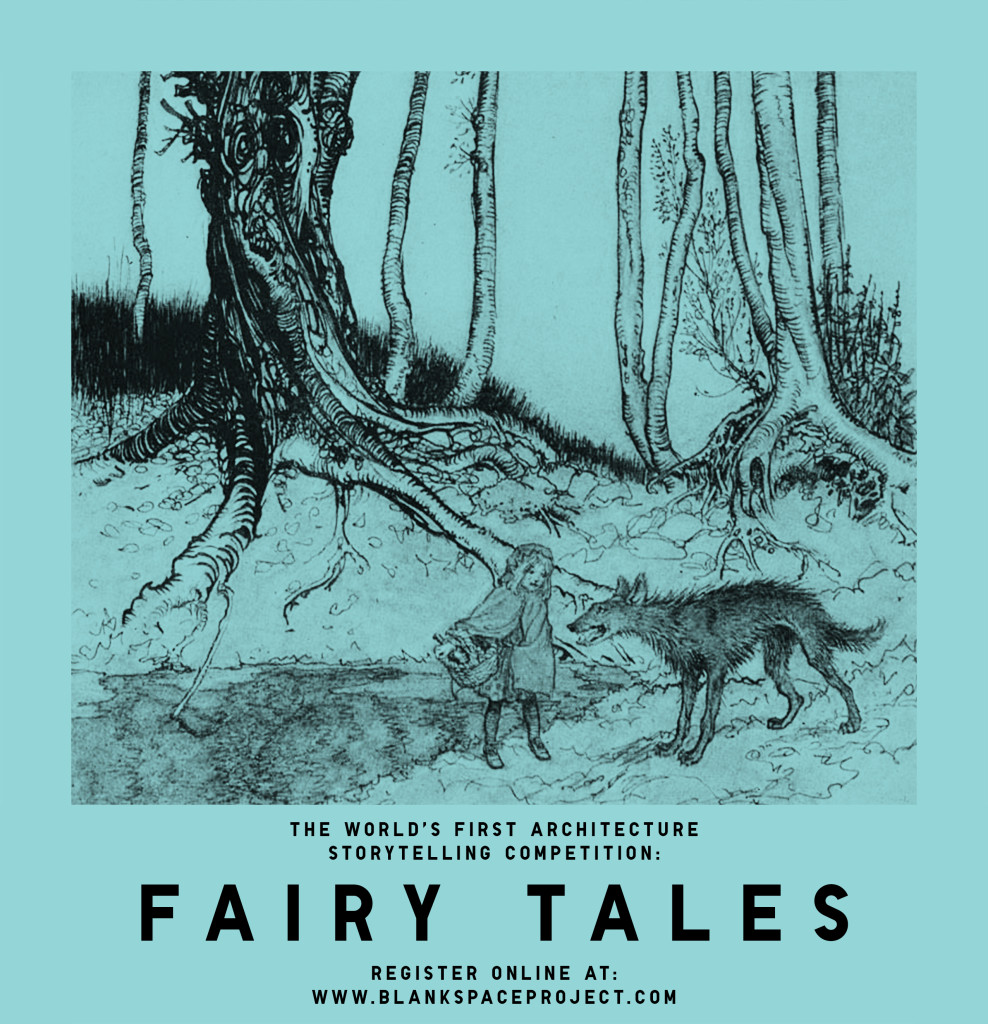Keep It Rio! | Rio CityVision Competition | FARM Prize

Alessandro Nardacci – Alessandro Oltremarini – Federico Marchi
interview by Sebastian Di Guardo
SDG: About your project, what struck me most is the idea of exchanging the roles so the rich go to the favelas, as if it were a fashion, while the poor live in the abandoned infrastructures. What attracted you to theme of inversion?
AAF: We wanted to exaggerate the process of gentrification which is characteristic of many cities. The variety of solutions that have occurred has allowed us to reveal the characteristics and contradictions (including architectural) of a city and the future that is expected in Brazil. This country aspires to the western model of development that is now in decline. What appears to be a reversal, in fact, is what, globally, has characterized the evolution of Western countries, a progress in the name of the people but has favored few and damaged many.
SDG: Do you believe you have produced a utopia that could be achieved in some way? After all, if we think of the boom in loft spaces, the reuse of industrial spaces for luxury apartments …
AAF: Exactly. This is already happening in Rio: the expropriations, the local police, the visits of pop icons like the Pope, Obama and Lady Gaga, are all engaged by the favela fever and the exacerbation of media that encourages a shift of functions, values and roles of some structures and of entire areas of the city. It will probably not be long before the houses of the favela become artist studios, galleries and boutiques (every metropolis has a right to it’s Williamsbourgh!).
SDG: As for your architecture, utopically imagined as a winner, it assumes such value in such a special social context, that is so various,to the point that one could expect it to take root in reality?
AAF: Our vision is based on the failure of urban planning and policy decisions with regard to the speed and unpredictability of the company, the abuse of architecture at the expense of nature, and the approach of self-superstars who refuse, in part, rightly, social commitment and civil architecture, and propose instead a propaganda model, a stylistic exercise. We believe that the necessary interventions to the context of the favelas should be radical. The inhabitants of the favelas do not need a roof garden and an infinity pool: Rio reflects a kaleidoscopic context where the intervention possibilities multiply. This offers interesting and almost endless solutions. Probably very soon we will see an Apple Store in the favelas, but we are not so pessimistic …
SDG: Infact, you have not proposed a positive reality. In the end, as always, the weak use the resources that have been discarded by those who have too much.
AAF: It’s a story that repeats itself… The proposal is not really positive because the context from which it arises is not positive. The largest trade event does not bring with it any lasting social benefit. A city that lays the basis for its development on fragile foundations will soon see this house of cards collapse. Forcing the concept we proposed this reversal where no one wins, we all lose indeed. The rich live of the imaginary, the poor must “adapt”. Until we change the system, this will be the only cycle that we can witness, and in this case the architecture will be doomed to failure.
SDG: Not only: the city is enriched with forms and symbols of progress totally detached from a particular context, such as being replicated in series, or in fact, brought – by helicopter?! – From another area and imposed on the city.
AAF: The “big event” needs a highly iconic character to exist and survive. Rio, with the World Cup + Olympic packageis,
a newly conquered land; simple business operations are expressed in a fight between styles. Certainly the style is a subjective response to an objective question, which is both inevitable and right. But if this attitude is reduced to give well-managed and non-contextualized recipes, and capitalism raises towers designed by famous architects without thinking about the real problems and alternative solutions, and the favelas of Rio are cleared for advertising, then you have yet another confirmation that the mission of the architect, his social duty, is reduced to a signature. The architecture is in fact empty and abandoned.
SDG: You have not created a macro-system, nor a series of typical elements that form a city-system: you gave a, colorful, carioca, inclusive image of a future without global disasters. Why this choice? Perhaps the disaster is already the city itself, a reflection of a society without balance?
AAF: Focusing on what we thought was disgusting and grotesque, and expressing it, we could not avoid the wonder that self-generated. The city is a daily miracle, living on a tenuous balance. A catastrophe implies a distortion, an end. In reality, we thought that what is more disgusting in a city like Rio, is the continuous repetition of a cycle based on a system that was deceivingly meant to be a winner but failed in the end. A cycle in a balance of opposites and thus unfair. The real catastrophe is a society that has not yet embraced the idea that only a broader vision can achieve appropriate solutions for the development of our habitat.
SDG: What I believe unites the present and the future that you imagined is the great confusion, the crowd, an irrational side that attracts us. It seems to me that this is the only common denominator between the two time periods, is that so?
AAF: Yes and no. In the sense that the crowd is made up of different social classes. In the analysis of the present and imagining the future of Rio, what could only arise was exacerbation of the problems and contradictions. But above all, what arose was the crazy and colorful essence of a people and the breathtaking beauty of it’s constant struggle to preserve its uniqueness. It was natural for us to think of a future in which the poor are forced to live in a place so exclusive, in fact, excluded, such as the beach of Rio: a place designed for the rich. We have not imagined a better future but only a possible future and and we’d be well under way if our vision would be looked upon as a bad dream.
SDG: Rio is a sick and ambiguous city. Will it be so in the future? Will the wonder and the disgust still exist? Why do you think? What are wonder and disgust to you?
AAF: We do not believe that there can be a world completely white, pure and without any contradiction or ambiguity. We hope instead that there is justice and equal opportunities. The ambiguity and contradictions are the greatest resources for Rio and maybe will still be so in the future, but the city could suffer a fatal depersonalization that could fatally undermine it’s essence. In the case of architecture, it is often an expression of power (= expression of disgust/sick). But it is also an artistic language (= expression of wonder). Disgust and wonder are the two sides of the same coin, they are the attraction and repulsion that move the world every day. They are the human, the unconscious and the visceral and they can not disappear as long as the human being will be aware and independent. Apart from architecture, disgust and wonder walk parallel to the development of Rio even after that, once the hangover of globalization is over, the city will take over it’s destiny and finally decide what it wants to be.
ITALIAN VERSION _____________________________________________
SDG: Ciò che mi ha colpito di più nel vostro progetto è l’idea dello scambio dei ruoli, con i ricchi che vanno nelle favelas come fosse una moda, e i poveri che abitano le infrastrutture abbandonate…cosa vi ha attirato di questa tematica dell’inversione?
AAF: Abbiamo voluto estremizzare il processo di gentrification caratteristico di molte metropoli. La molteplicità delle soluzioni che si sono presentate ci ha permesso di mettere a nudo le caratteristiche e le contraddizioni, anche architettoniche, di due estremi di una città e del futuro che si prospetta per un paese come il Brasile, che aspira al modello di sviluppo occidentale ora in declino. Ciò che sembra un’inversione nello sviluppo locale, in realtà è la ripetizione di quello che globalmente ha caratterizzato l’evoluzione occidentale: un progresso in nome di molti, a favore di pochi e a danno di tanti.
SDG: Credete di aver prodotto un’utopia che potrebbe realizzarsi in qualche modo? In fondo se pensiamo al boom degli spazi loft, cioè al riuso di spazi industriali per appartamenti di lusso…
AAF: Esattamente…ed anche a Rio sta già succedendo: gli espropri, la polizia locale, le visite di icone pop come il Papa, Obama e Lady Gaga…sono tutti presi dalla febbre da favela e da un’esasperazione mediatica che incentiva uno spostamento delle funzioni, del valore e dei ruoli di alcune strutture e di intere aree di città. Probabilmente non ci vorrà molto prima che le abitazioni della favela diventino studi d’artista, gallerie e boutique (ogni metropoli ha diritto alla sua Williamsbourgh!).
SDG: Quanto la vostra architettura, utopisticamente immaginata come vincente, assume valore in quel contesto sociale così particolare e vario, al punto che ci si potrebbe aspettare che alligni nella realtà?
AAF: La nostra visione si basa sul fallimento dei piani urbanistici e delle decisioni politiche di fronte alla rapidità e imprevedibilità della società, all’abuso dell’architettura a discapito della natura; e sull’approccio autoreferenziale delle archistar che rifiutano, in parte giustamente, l’impegno sociale e civile dell’architettura, proponendone un modello propagandistico, un esercizio stilistico. Crediamo che gli interventi necessari al contesto della favela dovrebbero essere radicali. Non è un giardino pensile o una piscina a sfioro quello di cui gli abitanti della favela hanno bisogno: Rio riflette un contesto caleidoscopico dove le possibilità di intervento si moltiplicano offrendo soluzioni interessanti e pressoché infinite. Probabilmente presto vedremo veramente un Apple Store in favela, ma non siamo poi così pessimisti…
SDG: Infatti avete proposto una realtà non positiva, alla fine come sempre i deboli usano le risorse “scartate” da chi ha troppo…
AAF: É una storia che si ripete… La realtà proposta non è positiva perché non positivo è il contesto da cui nasce. Il grande evento commerciale non porta con se alcun beneficio sociale duraturo. Una città che pone le sue basi di sviluppo su fondamenta troppo fragili vedrà presto crollare questo castello di carte. Forzando il concetto abbiamo proposto quest’inversione dove nessuno vince, anzi perdiamo tutti. Il ricco vive di immaginario; il povero deve “adattarsi”. Finché non cambierà il sistema, questo sarà l’unico ciclo a cui possiamo assistere, ed in questa ipotesi l’architettura sarà destinata al fallimento.
SDG: E non solo: la città si arricchisce di forme e simboli del progresso totalmente avulsi da un contesto particolare, come replicati in serie, o appunto, portati – in elicottero?! – da un altro ambito e imposti alla città.
AAF: Il “grande evento” necessita di un carattere fortemente iconico per esistere e sopravvivere. Rio, col pacchetto Mondiali + Olimpiadi, è una nuova terra di conquista; semplici operazioni commerciali si esprimono in una lotta tra stili. Certamente lo stile è una risposta soggettiva ad una domanda oggettiva, ed è tanto inevitabile quanto giusto che esista. Ma quando si appiattisce su ricette ben riuscite e per nulla contestualizzate, quando il capitalismo innalza torri “griffate” senza tener conto dei problemi reali e delle soluzioni alternative, quando nelle pubblicità scompaiono le favela dalle viste aeree di Rio, allora hai l’ennesima conferma che la missione dell’architetto, il suo dovere sociale, si riduce ad una firma, un’architettura vuota e infatti abbandonata.
SDG: Non avete creato un macro-sistema, ne una serie di elementi tipici che formano un sistema-città: avete dato un’immagine, variopinta, carioca, inclusiva di un futuro senza catastrofi mondiali. Perché questa scelta? Forse la catastrofe è già la città stessa, specchio di una società senza equilibrio?
AAF: Concentrandoci su ciò che ritenevamo disgustoso e grottesco, ed esprimendolo, non abbiamo potuto evitare la meraviglia che si è autogenerata. La città è un miracolo giornaliero, vive in un labile equilibrio. La catastrofe implica uno stravolgimento, una fine. In realtà quello che di più disgustoso potesse esserci in una città come Rio, abbiamo pensato che fosse la ripetizione continua di un ciclo basato su un sistema illusoriamente vincente ma in pratica fallimentare. Un ciclo in un equilibrio fatto di opposti, ma quindi ingiusto. La vera catastrofe è una società che ancora non ha abbracciato l’idea che solo una visione più ampia potrà concretizzare soluzioni idonee per lo sviluppo del nostro habitat.
SDG: Ciò che credo accomuni il presente e il futuro che avete immaginato è la grande confusione, la folla, un lato irrazionale che ci attira. Mi sembra essere questo l’unico comune denominatore tra i due periodi temporali, è così?
AAF: Si e no. Nel senso che la “folla“ è costituita da classi sociali differenti. Nell’analisi del presente e nell’immaginare il futuro di Rio, non poteva che scaturire un’esasperazione dei problemi e delle sue contraddizioni, ma soprattutto è scaturita l’essenza folle e colorata di un popolo e la bellezza struggente della sua lotta continua per mantenere intatta la propria unicità. Ci è venuto naturale pensare ad un futuro in cui sono i poveri delle favela costretti a vivere in un posto così esclusivo, anzi, escluso, come la spiaggia di Rio: un luogo centrale pensato per ricchi. Non abbiamo immaginato un futuro migliore ma solamente un futuro possibile e saremmo già a buon punto se si guardasse la nostra visione come un brutto sogno.
SDG: Rio è una città contraddittoria, ambigua. Lo sarà anche in futuro? Rimarranno sia il disgusto che la meraviglia? Perché lo credete? Cosa sono per voi disgusto e meraviglia?
AAF: Non crediamo che possa esistere un mondo completamente bianco, puro e senza contraddizioni o ambiguità. Auspichiamo invece che ci siano giustizia e pari opportunità. L’ambiguità e la contraddittorietà sono per Rio la maggior risorsa e forse lo saranno anche in futuro, ma la città potrebbe subire una fatale spersonalizzazione che ne comprometterebbe fatalmente l’essenza. Nel caso dell’architettura, essa è spesso espressione di potere (= espressione di disgusto). Ma è anche linguaggio artistico, (=espressione di meraviglia). Disgusto e meraviglia sono le due facce di una stessa medaglia, sono l’attrazione e la repulsione che ogni giorno muovono il mondo, sono l’umano, l’inconscio e il viscerale e non possono scomparire finché l’essere umano sarà consapevole e indipendente. A prescindere dall’architettura, il disgusto e la meraviglia cammineranno paralleli nello sviluppo di Rio anche dopo che, superata la sbornia della globalizzazione, la città prenderà in mano il suo destino e deciderà finalmente cosa vorrà essere.
Related Posts :
Category: Article
Views: 9243 Likes: 0
Tags: Alessandro Nardacci , Alessandro Oltremarini , FARM , farm cultural park , Federico Marchi , rio , rio cityvision competition , Sebastian Di Guardo , Sick & Wonder
Comments:
Info:
Info:
Title: Keep It Rio! | Rio CityVision Competition | FARM Prize
Time: 23 settembre 2013
Category: Article
Views: 9243 Likes: 0
Tags: Alessandro Nardacci , Alessandro Oltremarini , FARM , farm cultural park , Federico Marchi , rio , rio cityvision competition , Sebastian Di Guardo , Sick & Wonder






